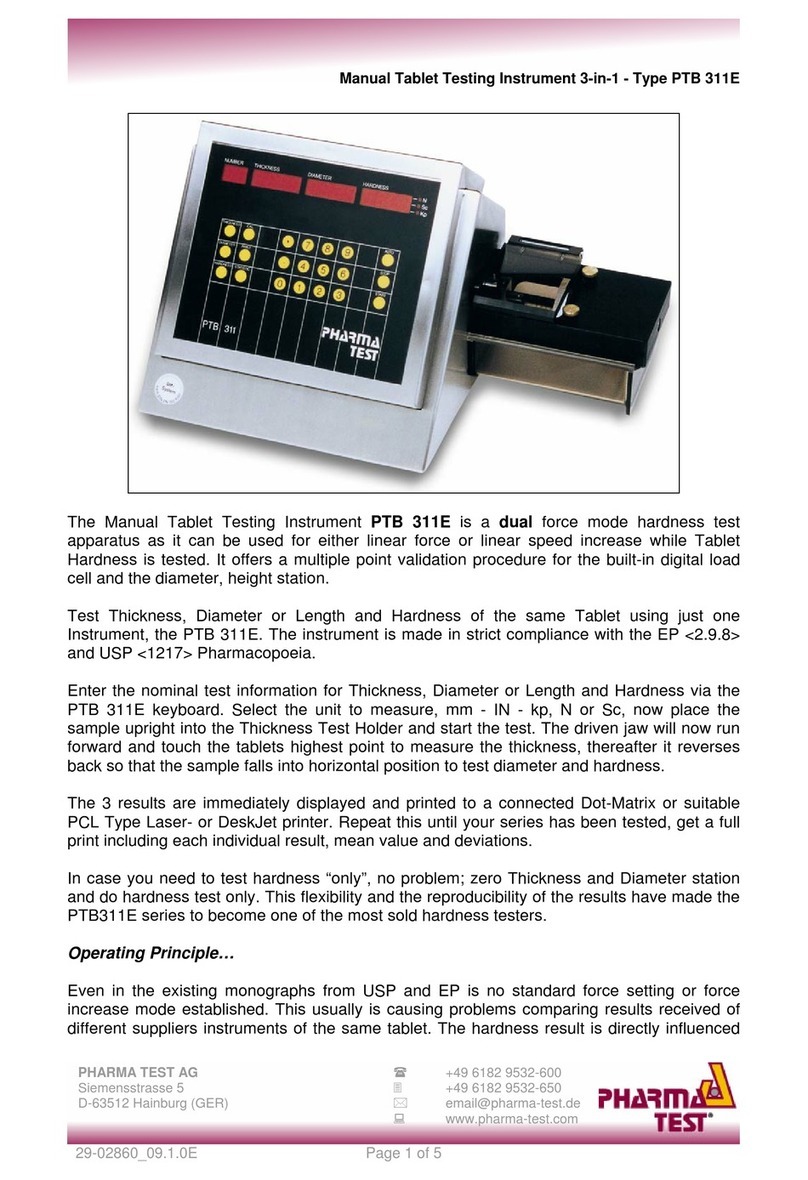Manual Tablet Hardness Testing Instrument - Type PTB 111E
29-02840_01-2011E Page 2 of 4
PHARMA TEST AG +49 6182 9532-600
Siemensstrasse 5 +49 6182 9532-650
www.pharma-test.com
Operating Principle…
Even in the existing monographs from USP and EP is no standard force setting or force
increase mode established. This usually is causing problems comparing results received of
different suppliers instruments of the same tablet. The hardness result is directly influenced
by the contact speed and force increase rate. Faster operated test jaw means lower
reproducibility and often higher results. In order to offer the possibility to select an operating
mode which will offer you similar results as the instruments you may already use, we allow to
select the force mode, linear force increase or linear speed increase as we do for the rate.
The only parameter we do not alter is the force touching the sample which is for all Pharma
Test Hardness Test Instruments very low as if you would try to break by hand. When touched
we start to increase.
Which force mode to select ?
Since more than 15 years all PHARMA TEST Hardness Test instruments offer the possibility
to select either linear Force or linear Speed increase.
Linear force increase certainly offers the most accurate control, as the rate of increase is
directly controlled by the electronically load cell used to read the force. Also it is quite simple
to validate the correct and linear operation as a Tablet of 100 Newton hardness will be
broken within 5 seconds if 20N/s had been set.
Linear speed increase can also be used. Here the driving speed of the motor is kept linear.
Actually if the touching force is kept low there is not too much difference in results between
the 2 systems.
Calibration and Validation
Built-in calibration and validation program for the
hardness station. To validate the hardness test station the
PT-MT magnetic tablet or different certified weights are
used. Use the PT-MT to qualify the correct breakpoint
detection, select a force, for example 50, 85 or 130 N
and run a test series, the resolution of the results should
be within 1.0N. The PT-MT instrument works like a tablet,
it withstands force and than “breaks”. For the 2 point
calibration of the hardness station a certified reference
weight of 10 kg is used for validation use 5, 10 and 15kg
weights. All calibration and validation results can be printed and countersigned. The PT-MT
will be used to qualify both, breakpoint detection as well as correctness of the set force
increase rate.
To prove the linearity of the instrument, the operator can program a print-out of the force
curve recorded during a test. This will show the linear increase of the adjusted force mode.
Also different weights, like the PTB-CAL15 which includes 5, 10, and 15kg, may be placed
onto the load cell or the PT-MT shall be used to validate the linearity. Using the parallel Port
a Matrix or PCL5 printer can be added and using the RS-232 COM port, all results can be
transmitted to a software program running on a computer system.























